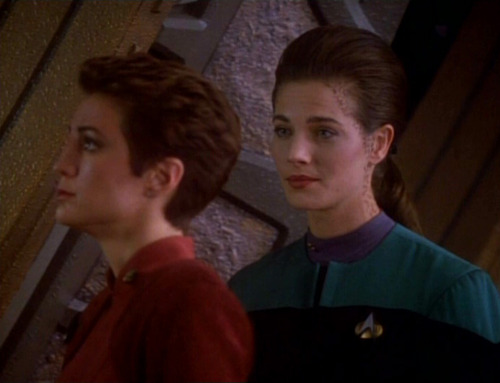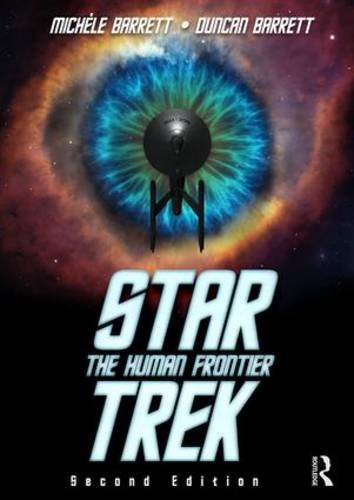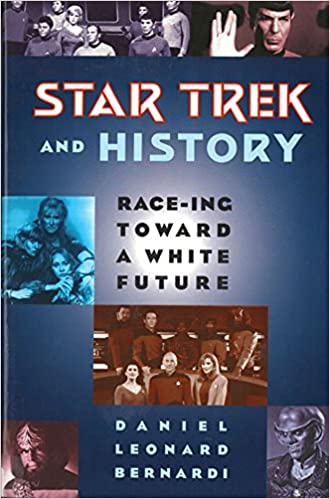
In spite of the fact that Star Trek has been an enduring force in our culture for over 50 years now, the literature on Star Trek and race remains limited, and most of what has been written on the subject has been by academic publishers for academic audiences.
The most prominent text is Daniel Leonard Bernardi’s Star Trek and History: Race-ing Toward a White Future (1998), which does a great job analyzing some of Trek’s problematic racial narratives, such as the tendency to portray more “evolved” or more powerful races as white (*cough* Q *cough*) and more primitive or less “evolved” races as brown (e.g. TOS’ “The Apple“).
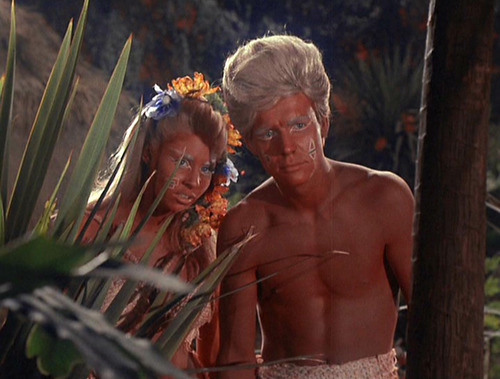
Bernardi, a Professor of Cinema at San Francisco State University who originally started analyzing race in Trek as his dissertation, argues that while Star Trek outwardly prevents a vision of diversity, it has a problematic history anti-miscegenation messages and essentialist racial stereotypes. He contends that Trek ultimately promotes assimilation rather than meaningful integration of people of colour and various alien “Others.” His analysis is intersectional with gender and he uses many examples to back up his claim, with enough explanation that a somewhat casual fan should be able to follow.
The weakest part of the book is the end section where the author attempts to gauge fandom viewpoints on race in Trek through engaging on the STREK-L Internet listerver from 1992-1994. The resulting chapters are clunky and wanting for more thorough or comprehensive analysis of the fans’ comments. For example, Bernardi shares several fans’ opinions on how alien races on Trek may or may not reflect IRL human ethnicities. A section on the Klingons talks about the acknowledged history (Klingons as the Soviet Union) as well as conflicting perceptions of the Klingons as stand-ins for African-Americans. But Bernardi only presents three views and doesn’t delve into the significance of the fans’ standpoints or contents of their remarks.
Overall, given how little there is out there, and the fact that this is a very accessible read for a piece of academic literature, this is a pretty essential read for progressive/critical thinking Trek fans, even 20 years later.
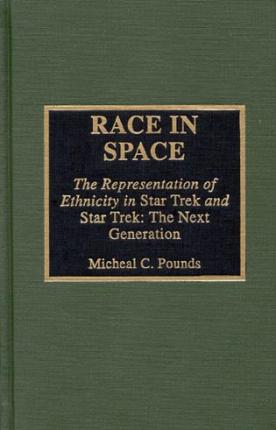
Race, this country’s tragically misunderstood issue, is humanity’s real final frontier. It seems clear from this analysis of two science fiction television programs spanning more than a quarter of a century that very little, if any, real progress has been made in developing symbolic codes of representing ethnicity in the elaborate vision of the future woven across hundreds of hours of popular entertainment that counters our national legacy of abusive media stereotyping.
Micheal C. Pounds
The other book that’s notable in this space is harder to find, but I did manage to find a copy through my local library: Race in Space: The Representation of Ethnicity in Star Trek and Star Trek: The Next Generation by Micheal C. Pounds (1999).
Pounds, who teaches in the film department at California State University, is more explicit about his personal connection to the subject matter. In the introduction he discusses what it was like growing up an African-American during segregation, and how he started to notice that the shows coming on his TV screen didn’t look like the world he lived in.
Pounds makes a smart call to restrict his analysis to the first two live-action Trek series, given the time of publishing. One of his stated goals is to compare two series that could cite Gene Roddenberry as a common creative force, in two very different socio-political time periods.
The book starts very strong with a look at the changing social context of television production and reception. In spite of my own interest in Star Trek, social justice and labour history, I had no idea about the very concerted campaigns by the NAACP and others to increase and improve representations of Black people on-screen and behind the scenes in Hollywood in the years leading up to the premiere of Star Trek: The Original Series.
There is a myth in Star Trek fandom that Trek really pushed the envelope on race beyond what other shows were doing, and that it was almost entirely due to Gene Roddenberry being an enlightened guy who believed in diversity. What’s missing from that picture is the intense lobbying effort outlined in this book for all studios, Hollywood craft unions, and writers’ and actors’ guilds to move in this direction, which surely softened the ground for Roddenberry and TOS. Apparently NBC Vice-President Mort Werner even reminded Roddenberry in a memo that the network had a “long-standing policy of non-discrimination” that captures treatment of people working on their shows, but also:
[We are] determined that members of minority groups be treated in a manner consistent with their role in society…While this applies to all racial minorities, obviously the principal reference is to the casting and depiction of Negroes…Our purpose is to assure that our medium, and within permissive framework of dramatic license we present a reasonable reflection of contemporary society…We urge producers to cast Negroes, subject to their availability and competence as performers, as people who are an integral segment of the population, as well as in those roles where the fact of their minority status is of significance. An earnest attempt has been made to see that their presence contributed to an honest and natural reflection of places, situations, and events and we desire to intensify and extend this effort.
However, as I continued to read I found the text significantly denser than Bernardi’s book and I had to really question the methods that Pounds chose to investigate representations of race in Star Trek, as well as the way he presented his findings.
For example, Pounds spends a fair chunk of time investigating the name origins of the main characters in TOS and TNG and trying to infer deeper meanings from them. He also analyzes two publicity photos (one from each series) to infer relationships and hierarchies among the characters, but when you’re a fan who knows how many publicity photos there are from both series, picking these particular ones seems like cherry-picking to support his hypothesis.
Bernardi founds his analysis on three episodes from TOS (“Space Seed”, “The Ultimate Computer” and “Plato’s Step-Children”) and four from TNG (“Emissary”, “Reunion”, “Booby Trap” and “Galaxy’s Child”), leaving some really low-hanging-fruit episodes like “Code of Honor” and “The Paradise Syndrome” totally unanalyzed.
The way he presents the information is also less than ideal: outlining a bunch of scenes from these episodes in one chapter without any analysis, then stuffing the analysis into the next chapter but relying on our memory of the scenes.
In addition, stumbles into conclusions that fans on the internet today would hastily correct, like asserting that while Rand has a friendship with Spock, her relationship with Kirk is “limited to her job and kept totally professional.” Ummmm…

One big problematic area is that Pounds twice refers to Asian characters as having the same light-skinned privilege as white people (Sulu and Keiko), even arguing that Spock and Uhura are more racially othered than Sulu in TOS.
But in spite of all these issues I found myself agreeing with a lot of Pounds’ eventual findings. He aligns with Bernardi on two key points: his negative evaluation of how Trek handles interracial breeding and biracial children, and his assessment of TNG in particular as an assimilationist narrative.
He also cites Trek for depicting racialized men like Khan and Worf as violent, and particularly as a potential threat to white women (Marla and K’Ehleyr respectively).
Klingon culture is given elaborate, even baroque treatment, but the details are superficial and so do not present any situations or characters that force human characters to re-examine themselves or their motives.
On the issue of alien “Others” like the Ferengi or Romulans, Pounds notes that they are often seen as monocultures that our Starfleet heroes are encouraged to despise and not to learn from. Even when they are designed to be villains, he questions whether they need to be depicted the way they are: “There is no hard and fast rule that malevolence must be one-dimensional, obvious, and predictable.”
Pounds also suggests ways of reading episodes and scenes that I hadn’t previously considered, such as parallelling La Forge and Daystrom as Black men who have better relationships with technology than people. He talks about the downside of La Forge’s VISOR being that he is almost never able to generate a point-of-view shot, which means he is more than any other character the subject of the ongoing white gaze of the other characters/filmmakers/audience.

Ultimately Pounds finds Trek’s racial representations – as well as the representations in most mainstream media – lacking, and he concludes the book with a powerful expression of his own frustration and disappointment:
I have been waiting for more than two decades for the leaders of American media to turn their considerable business acumen to the issue of developing products that position this country in the vanguard of the issues of equality. I have been waiting for African American actors to move from the background as details used to flesh out a contemporary atmosphere to the middle and foreground as characters whose storylines affect the plot in consequential ways.
I am curious whether Pounds or Bernardi is at all active in Star Trek fandom today and what they would think of the new series that have come out post-1999. I also think there is lots of room for more writing on this topic – including non-academic writing.









